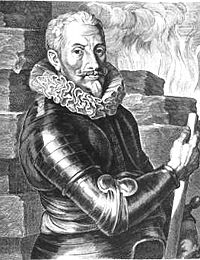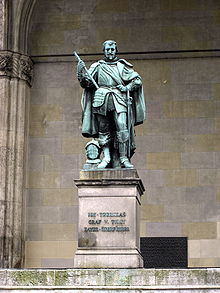- Johann Tserclaes, Count of Tilly
-
Johann Tserclaes, Count of Tilly 
Count Tilly on a portrait by van Dyck.Nickname the Monk in Armor Born February, 1559
Castle Tilly, Walloon Brabant, BelgiumDied 30 April 1632 (aged 73)
Ingolstadt, BavariaAllegiance  Spain
Spain
 Holy Roman Empire
Holy Roman Empire
 Bavaria
BavariaYears of service 1574 - 15 April 1632 Battles/wars Eighty Years' War
Thirty Years' WarJohann Tserclaes, Count of Tilly (Dutch: Johan 't Serclaes) (February 1559 – 30 April 1632), commanded the Imperial forces in the Thirty Years' War. He had a string of important victories against the Protestants but was then defeated by forces led by the King Gustavus Adolphus of Sweden. Along with Duke Albrecht von Wallenstein of Friedland and Mecklenburg, he was one of two chief commanders of the Holy Roman Empire’s forces.
Contents
Early years
Johann Tserclaes was born in February 1559 in Castle Tilly, Walloon Brabant, now in Belgium, then the Spanish Netherlands. Johann Tserclaes was born into a Roman Catholic Brabantine family and after receiving a Jesuit education in Cologne, he joined the Spanish army at age fifteen and fought under Alessandro Farnese, Duke of Parma and Piacenza in his campaign against the Dutch forces rebelling in the Eighty Years' War and participated in the successful Siege of Antwerp (1584–1585) in 1585. After this he joined in the Holy Roman Empire’s campaign against the Ottoman Turks in Hungary and Transylvania as a mercenary in 1600 and through rapid promotion became a Field Marshal in only five years.
Campaign in Bohemia
Following this he was appointed commander of the Catholic League forces by Bavaria under Maximilian I, Elector of Bavaria in 1610 and fought against the Bohemian rebels in 1620, by which time he had trained his soldiers in the Spanish Tercio system, which featured musketeers supported by deep ranks of pikemen. With 25,000 soldiers, he moved north and scored an important victory against Frederick V, Elector Palatine at the decisive Battle of White Mountain north of Prague on 8 November 1620, in which half of the enemy forces were killed or captured, losing only 700 men, because his men were so well trained they required only two hours of fighting to break the enemy line. This was vital in crushing resistance to the emperor in Bohemia, as it allowed Prague to be captured several days later.
Campaign in Germany
Next he turned west and marched through Germany, but was defeated at the Battle of Mingolsheim on 27 April 1622. He then joined with the Spanish general Duke Gonzalo Fernández de Córdoba, (not to be confused with the famous Spanish general of the same name, famous from the Italian Wars in Italy at the end of the 15th century), and was victorious at the Battle of Wimpfen against Georg Fredrick, Margrave of Baden-Durlach on 6 May; this victory occurred after the enemies’ ammunition tumbril was hit by cannon fire and exploded.
He was successful again at the Battle of Höchst on 20 June and was made a Count (Graf in German) for this victory. These three battles in two months allowed him to capture the city of Heidelberg following an eleven-week siege on 19 September. Christian the Younger of Brunswick, whom he had already defeated at Höchst, raised another army, but again lost to him at the Battle of Stadtlohn where 13,000 out of his army of 15,000 were lost, including fifty of his high ranking officers. Together with the complete surrender of Bohemia in 1623, this ended virtually all resistance in Germany.
This caused king Christian IV of Denmark to enter the Thirty Years' War in 1625 to protect Protestantism, and also in a bid to make himself the primary leader of Northern Europe. Count Tilly besieged and captured Münden 30 May 1626, whereupon local and refugee protestant ministers were thrown into the Werra river, but could not lay a siege to Kassel.[1] Count Tilly, Johann Tserclaes then fought the Danish at the Battle of Lutter on 26–27 August 1626 in which his highly disciplined infantry charged the enemy lines four times whereupon they broke through, leading him to win decisively, and destroying more than half the fleeing Danish army; as was uncharacteristic of warfare of the times. Because of this and other victories by Wallenstein, Denmark was forced to sue for peace at the Treaty of Lübeck, but this disrupted the balance of power in Europe resulting in Swedish involvement in 1630 under their redoubtable leader, the brilliant King and Field General Gustavus Adolphus of Sweden who had been attempting to dominate the Baltic for the previous ten years in wars with Poland, then a continental power of note.
Sack of Magdeburg
While Adolphus landed his army in Mecklenburg and was in Berlin, trying to make alliances with the leaders of Northern Germany, Johann Tserclaes laid siege to the city of Magdeburg in central Germany on the Elbe River, which promised to support Sweden.
The siege began on 20 March 1631 and he put his subordinate Gottfried Heinrich Graf zu Pappenheim in command while he campaigned elsewhere. After two months of laying siege, and after the fall of Frankfurt (Oder) to the Swedish, Pappenheim finally convinced Tilly, who had brought reinforcements, to storm the city on 20 May with 40,000 men under the personal command of Pappenheim. The assault was successful and the walls were breached, but the commanders supposedly lost control of their soldiers and a massacre of the populace ensued in which 25,000 of the 30,000 inhabitants of the city perished by sword and the fire which destroyed most of the city. The city, then among the major places in Germany and of the size of Cologne or Hamburg, never recovered from this disaster.
This is a highly controversial event in Johann Tserclaes’ career and historians still debate how much responsibility he bears for what happened. His enemies quickly blamed him, claiming that the massacre was ordered and used it as justification to enact similar killings. But many historians consider it unlikely that he ordered the city torched. Magdeburg was a strategically vital city of the Elbe River and was needed as a resupply center for the looming fight against the Swedes. Although extremely opposed to the Reformation movement, Tserclaes was a very experienced commander and would have recognized the strategic importance of the city. Additionally, he sent a proposal of surrender to Magdeburg days before the final assault, after the capture of the Toll redoubt. However the mayor of Magdeburg rejected any such proposal, expecting the Swedish relief force to arrive soon. When the slaughter began, and no escape was possible, the children of the city were formed in procession and marched across the market-place singing Luther's hymn: "Lord keep us steadfast in thy Word, Curb Pope and Turk who by the sword, would wrest the kingdom from thy Son, and set at naught all he hath done." The children were soon slain, whether or not this inhumane deed was ordered by Tilly is not certain. However, it is interesting to note that Tilly afterwards wrote to the Emperor,'Never was such a victory since the storming of Troy or of Jerusalem. I am sorry that you and the ladies of the court were not there to enjoy the spectacle'.
Campaign against the Swedish
Following Magdeburg, Johann Tserclaes engaged Gustavus Adolphus at the Battle of Breitenfeld on 17 September 1631, near the city of Leipzig, which Tserclaes had reached by laying waste to Saxony. In the battle he was outmaneuvered by King Gustavus Adolphus and lost 13,000 soldiers in the hard-fought battle. The Swedes’ maneuvering and accurate, rapid artillery fire caused his troops to break and flee. He withdrew, and political rivalries prevented Wallenstein from coming to his aid, so he turned to defense. While attempting to prevent the Swedish from crossing into Bavaria over the Lech River near the city of Rain am Lech, he was wounded by a cannon ball early in the Battle of Rain and died of tetanus fifteen days later in Ingolstadt at the age of 73 on 30 April 1632. His tomb is in Altoetting, Upper Bavaria.
Gustavus sent his own personal physician to tend to his wounds which caused Tilly to tell him, "Your king is truly a noble knight."
Descendants
A grandson of one of his brothers, Antonio Octavio Tserclaes de Tilly (1646–1715) was General of the Spanish Army.
A sister, or daughter, Albertina, of this Prince Antonio Octavio, would be the first root for the Spanish ducal title, Dukes of Tserclaes, bestowed in July 1856 by Queen Isabella II of Spain to members of the Guzman, Perez de Guzman, family, living in Jerez and Sevilla, Spain.
Fictional appearances
- Tilly is mentioned in Bertolt Brecht's Mother Courage and Her Children in the chapter where his funeral is held and where Mother Courage, referring to it, says her famous lines "I don't care if this funeral is historical event, to me the mutilation of my daughter's face is a historical event."
- Tilly and the sack of Magdeberg is mentioned in the novels "The Hangmans daughter." and "1632."
- Tilly is depicted in First Breitenfeld and in the battle of Rain in the novel 1632
References
- ^ Willigerod, Geschichte von Münden (Göttingen, 1808).
External links
Categories:- 1559 births
- 1632 deaths
- People from Walloon Brabant
- 17th-century German people
- South Netherlandish people of the Thirty Years' War
- Field Marshals
- German nobility
- House of 't Serclaes
- History of Bavaria
- Deaths from tetanus
- Flemish nobility
- Spanish generals
Wikimedia Foundation. 2010.

